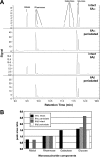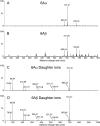Discovery of a new capsular serotype (6C) within serogroup 6 of Streptococcus pneumoniae
- PMID: 17267625
- PMCID: PMC1865839
- DOI: 10.1128/JCM.02199-06
Discovery of a new capsular serotype (6C) within serogroup 6 of Streptococcus pneumoniae
Abstract
Using two monoclonal antibodies, we found subtypes among pneumococcal isolates that are typed as serotype 6A by the quellung reaction. The prevalent subtype bound to both monoclonal antibodies and was labeled here 6Aalpha, whereas the minor subtype bound to only one monoclonal antibody and was labeled 6Abeta. To determine the biochemical nature of the two serologically defined subtypes, we purified capsular polysaccharides (PSs) from the two subtypes and examined their chemical structures with gas-liquid chromatography and mass spectrometry. The study results for 6Aalpha PS are consistent with the previously published structure of 6A PS, which is -->2) galactose (1-->3) glucose (1-->3) rhamnose (1-->3) ribitol (5-->phosphate. In contrast, the 6Abeta PS study results show that its repeating unit is -->2) glucose 1 (1-->3) glucose 2 (1-->3) rhamnose (1-->3) ribitol (5-->phosphate. We propose to continue referring to 6Aalpha as serotype 6A but to refer to 6Abeta as serotype 6C. Serotype 6C would thus represent the 91st pneumococcal serotype, with 90 pneumococcal serotypes having previously been recognized. This study also demonstrates that a new serotype may exist within an established and well-characterized serogroup or serotype.
Figures






References
-
- Abeygunawardana, C., T. C. Williams, J. S. Sumner, and J. P. Hennessey, Jr. 2000. Development and validation of an NMR-based identity assay for bacterial polysaccharides. Anal. Biochem. 279:226-240. - PubMed
-
- Butler, J. C., R. F. Breiman, J. F. Campbell, H. B. Lipman, C. V. Broome, and R. R. Facklam. 1993. Pneumococcal polysaccharide vaccine efficacy. An evaluation of current recommendations. JAMA 270:1826-1831. - PubMed
-
- Cole, R. 1913. Treatment of pneumonia by means of specific serums. JAMA 61:663-666.
-
- Cole, R. B. 1997. Electrospray ionization mass spectrometry: fundamentals, instrumentation, and applications. Wiley, New York, NY.
Publication types
MeSH terms
Substances
Grants and funding
LinkOut - more resources
Full Text Sources
Other Literature Sources

